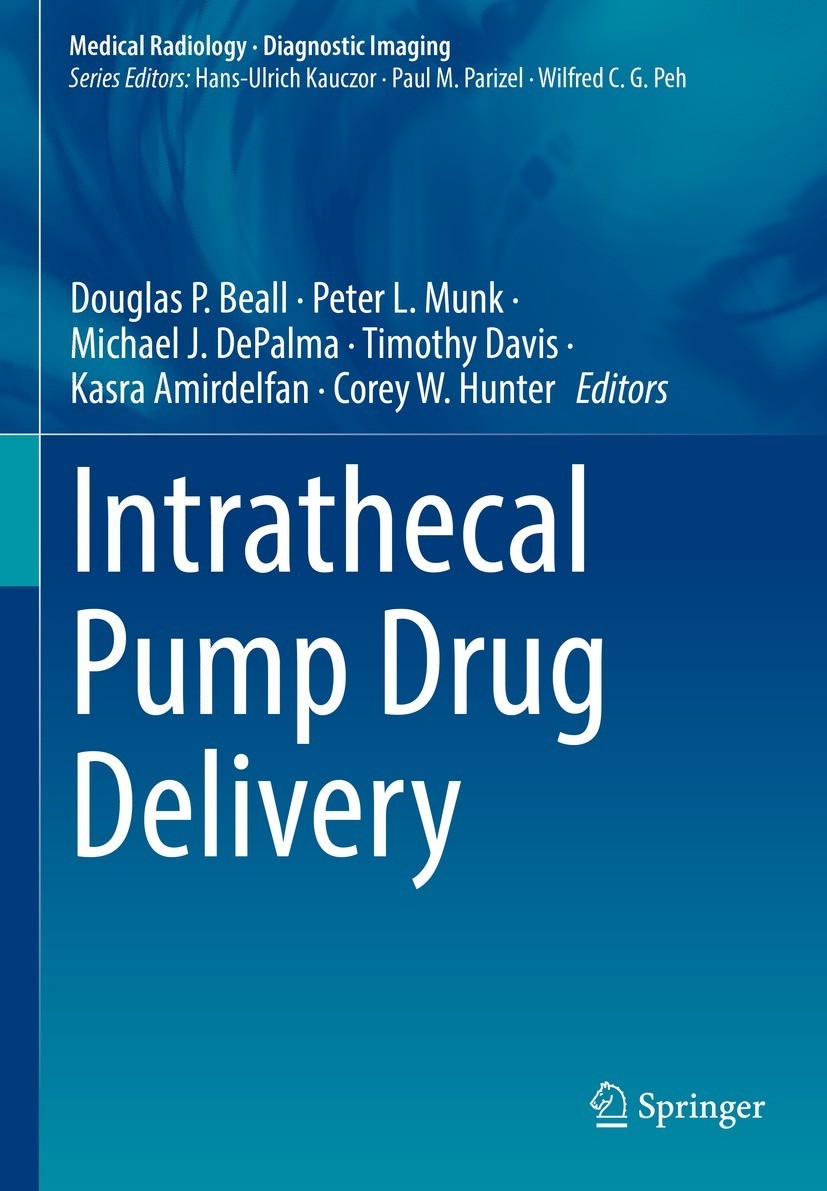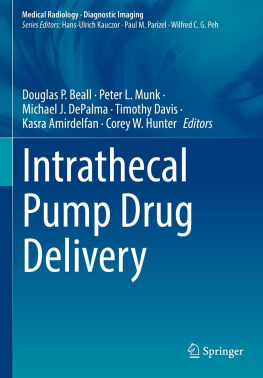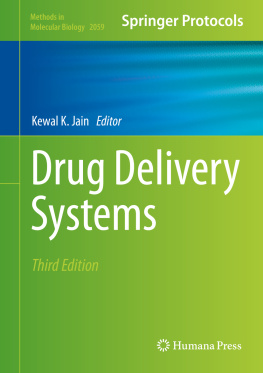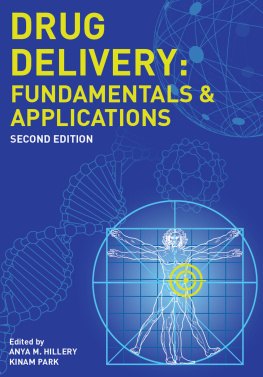Douglas P. Beall - Intrathecal Pump Drug Delivery
Here you can read online Douglas P. Beall - Intrathecal Pump Drug Delivery full text of the book (entire story) in english for free. Download pdf and epub, get meaning, cover and reviews about this ebook. year: 2022, publisher: Springer, genre: Romance novel. Description of the work, (preface) as well as reviews are available. Best literature library LitArk.com created for fans of good reading and offers a wide selection of genres:
Romance novel
Science fiction
Adventure
Detective
Science
History
Home and family
Prose
Art
Politics
Computer
Non-fiction
Religion
Business
Children
Humor
Choose a favorite category and find really read worthwhile books. Enjoy immersion in the world of imagination, feel the emotions of the characters or learn something new for yourself, make an fascinating discovery.
- Book:Intrathecal Pump Drug Delivery
- Author:
- Publisher:Springer
- Genre:
- Year:2022
- Rating:5 / 5
- Favourites:Add to favourites
- Your mark:
- 100
- 1
- 2
- 3
- 4
- 5
Intrathecal Pump Drug Delivery: summary, description and annotation
We offer to read an annotation, description, summary or preface (depends on what the author of the book "Intrathecal Pump Drug Delivery" wrote himself). If you haven't found the necessary information about the book — write in the comments, we will try to find it.
Intrathecal Pump Drug Delivery — read online for free the complete book (whole text) full work
Below is the text of the book, divided by pages. System saving the place of the last page read, allows you to conveniently read the book "Intrathecal Pump Drug Delivery" online for free, without having to search again every time where you left off. Put a bookmark, and you can go to the page where you finished reading at any time.
Font size:
Interval:
Bookmark:

The book series Medical Radiology Diagnostic Imaging provides accurate and up-to-date overviews about the latest advances in the rapidly evolving field of diagnostic imaging and interventional radiology. Each volume is conceived as a practical and clinically useful reference book and is developed under the direction of an experienced editor, who is a world-renowned specialist in the field. Book chapters are written by expert authors in the field and are richly illustrated with high quality figures, tables and graphs. Editors and authors are committed to provide detailed and coherent information in a readily accessible and easy-to-understand format, directly applicable to daily practice.
Medical Radiology Diagnostic Imaging covers all organ systems and addresses all modern imaging techniques and image-guided treatment modalities, as well as hot topics in management, workflow, and quality and safety issues in radiology and imaging. The judicious choice of relevant topics, the careful selection of expert editors and authors, and the emphasis on providing practically useful information, contribute to the wide appeal and ongoing success of the series. The series is indexed in Scopus.
More information about this series at https://link.springer.com/bookseries/174

This Springer imprint is published by the registered company Springer Nature Switzerland AG
The registered company address is: Gewerbestrasse 11, 6330 Cham, Switzerland

Douglas P. Beall, MD, FIPP, FSIR, DAAPM
Director Interventional Spine Care, Comprehensive Specialty Care,
Chief of Radiology Services and Director of Fellowship Programs,
Oklahoma City, OK, USA
This book is dedicated to all the practitioners who are willing to tackle complex therapies in order to ease their patients pain and improve their lives. My hope is that a comprehensive single source of information will help to optimize IDD therapy and improve your patients outcomes.
Intrathecal drug delivery (IDD) has been one of my very favorite treatments since I saw my first case performed in fellowship in the early 2000s and saw the incredibly good and immediate results. After transitioning from academia and into private practice I found myself inheriting 67 intrathecal baclofen patients from two physicians who were transitioning from managing this patient population to being employed hospitalists. As an Interventional Radiologist, my staff was unfamiliar and somewhat hesitant to accept this service line but did so anyway without hesitation and this patient population quickly became their favorite group.
Intrathecal medication delivery has since become an essential part of our medical and interventional practice. In patients who have certain conditions this therapy is absolutely essential including patients who have severe spasticity, multi-site pain, severe degenerative conditions without a surgical solution, patients with chronic pain on high-dose systemic narcotics, and metastatic cancer pain especially from a pancreatic source or those with bony metastases. I have found that IDD is often the only solution for some of the most complex patients and without it they simply do not receive optimal care.
As useful and essential as this therapy is it is, in my opinion, tremendously underutilized. I think there are two primary reasons for this. The first is that IDD has had its reputation tarnished in the early days of therapy where it was commonplace to provide oral opioid medication along with intrathecal opioids. As we now know, providing oral or systemic medication is a self-defeating strategy as it causes an upregulation of the cytochrome P-450 system to the point that there is no amount of intrathecal opioid that can be provided that can overcome the patients upregulated metabolic activity that eliminates the opioid very quickly and results in a very high tolerance to these medications. During the peak of the opioid epidemic, we were seeing patients with chronic pain that were on 5001000 MME of morphine or more for IDD trials. One of these patients was on an incredible 1200 MME of morphine daily and refused to taper his medication dose before the trial. We typically use a 1:100 ratio of intrathecal to oral MME of opioids for a bolus trial and keep the patients overnight with continuous monitoring of the pulse oximetry and cardiac activity and multiple vital signs measurements. In this patient, however I was very reluctant to give that amount of intrathecal morphine and settled on 8 mg of morphine injected as a bolus into the lumbar spine cerebrospinal fluid. We were prepared for treatment of an overdose of intrathecal medication but what happened was exactly the opposite with the patient receiving 23 h of excellent pain relief followed by a return of his pain to the point where he was unhappy, wanted to take his oral medication and checked out of the hospital against medical advice. This scenario permanently etched in my mind the absolute requirement not to use a combination of systemic and intrathecal medication as there is no amount of opioid that can be given intrathecally to overcome the hypermetabolism that results from systemic opioid administration.
Font size:
Interval:
Bookmark:
Similar books «Intrathecal Pump Drug Delivery»
Look at similar books to Intrathecal Pump Drug Delivery. We have selected literature similar in name and meaning in the hope of providing readers with more options to find new, interesting, not yet read works.
Discussion, reviews of the book Intrathecal Pump Drug Delivery and just readers' own opinions. Leave your comments, write what you think about the work, its meaning or the main characters. Specify what exactly you liked and what you didn't like, and why you think so.









